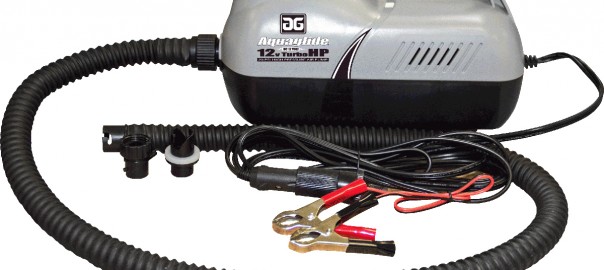Earlier this summer we received our first shipment of Kokopelli Outdoors‘ new Feather pump. The tiny 12-volt wonder weighs just under 6 oz, and was touted to quickly inflate or deflate one single-sized packraft chamber to 90% in 60 seconds.
Seemingly too-good-to-be-true, we took the opportunity to put it to work when setting up Kokopelli’s Rogue Lite packraft. So here is our review on the Kokopelli Feather pump.
Getting Started with the Kokopelli Feather Pump
The Feather pump comes in a small box with 5 adaptors, a drawstring carrying case, and a micro USB cable. The pump body weighs 5.9 oz and measures 3.25 x 2.25 x 2.5 inches – small enough to fit in your palm.
The five adaptors include A) a wider, low profile, white adaptor used with vacuum storage bags; B) a Boston valve adaptor as found on some air beds and inflatable kayaks; C) a slightly-smaller, white, low profile white adaptor used with inflatable rafts (like Kokopelli); D) a flexi-adaptor used for outdoor mattresses and E) a pointed nozzle adaptor for swim toys. The flexi adaptor works in conjunction with adaptors (A) or (C). (Please note, the following was done with a D7 Leafield valve, so if using another type you may need to play around a bit.)
The USB charger cable is 12 inches long, weighs 0.4 oz and is used to recharge the Feather pump by hooking into anything with a USB port – computer, solar charger, etc.
First step, put the valve into the open/deflate mode. At 0.27 PSI, the pump does not have enough torque to open the valve. So make sure the plunger is in the DOWN position (air goes in and and can come back out.)
The included instructions have very basic information on inflation and deflation. While the illustrations depict using the pointed nozzle adaptor (#E above), that will not work – the nozzle is too long to make any contact with the C7 or D7 Leafield valves found on Kokopelli rafts.
We took a look at the other 3 rigid adaptors and found each could work, as none actually couple to the valve, you just hold the pump over the valve.
There are two openings on the Feather pump – the one on the top is the deflate mode.
The one on the side is the inflate mode.
Put the smaller ring (C) onto the inflate opening and press the power button (opaque plastic membrane located on the side, above the USB port connection). Hold the adaptor over the valve.
Within a few seconds, you will start to see the body filling out. In fact, it took a whopping 56 seconds for me to inflate the entire Rogue Lite – a 7′ 1″ packraft with a 12″ diameter tube.
Once you








You must be logged in to post a comment.